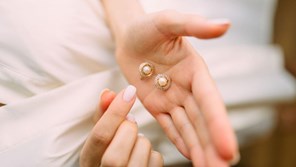How to get jewellery valued for insurance
5 minute read

As jewellery can be of great value - sentimental or financial - it is worth making sure it's protected. Some highly valuable items may need specific cover above that provided by standard home insurance policies.

Age Co Insurance
We offer products and services to help the over 50s get more out of later life and give our profits to the charity Age UK.
By understanding the true monetary value of your favourite jewels, you should be able to find the right protection. This means you'll be covered in the event an item gets lost or damaged, allowing it to be repaired or replaced easily.
To check if your jewellery can be covered by your home insurance, your insurance provider may need to know how much the jewellery is worth. If this step gets skipped, you may not receive as much, or any, compensation for the item as expected once your claim is complete.
What does it mean to get jewellery appraised?
An appraisal is simply another word for a valuation. When an item is appraised, an expert will inspect the piece of jewellery to provide a figure that it’s worth. The experts are trained and have a high level of knowledge in their field, so you can be sure that the valuation is accurate. If you’d prefer, you can have one item valued by multiple people for additional peace of mind.
The value of your jewellery could differ depending on a number of factors. These include…
- The condition of the item
- The shape
- The colour
- The clarity
- The size
- The weight
- The age
- The rarity
All of these things can have an impact on how much your item is worth.
It’s important to note that the valuation will demonstrate how much the item is worth at that time and not what it was from new or when you bought it. Depending on the item, this could be more or less.
Special cases
The value of jewellery can be massively dependent on the history of the item and who made it. One example boasts of a ring that was taken to be valued by the owner, who simply thought it was costume jewellery. The valuer found the inscription ‘Chanel’ tucked inside a twist within the piece. As it was once worn by Gabrielle Chanel herself, it sold for £68,500.
Of course, these kinds of pieces are unlikely to be found in the average home, and impossible if your item was bought brand new. But it goes to show that a valuation isn’t necessarily about the rarity of a diamond or how much it weighs, but also about its past and provenance.
How to get jewellery valued for your insurance company
In order to get your jewellery appraised, you must first find a reputable valuer who you can trust will provide you with an accurate price. You may find that your insurance provider can recommend someone for you.
Where to get jewellery valued
There are a few places you can start when it comes to getting your jewellery valued. The best place might be the Institute of Registered Valuers (IRV), who are the UK's leading authority of jewellery, watch and silverware appraisers. They maintain exacting standards for the longest-serving and most recognised valuation trade body and are regulated by the National Association of Jewellers. This makes them very reputable, and you’re likely to find a qualified valuer in your local area. You could also try the Association of Independent Jewellery Valuers.
Once you’ve picked someone from either of these lists, you should check to see if they’re registered with the IRV or other certified authority.
Important: be careful when accepting valuations ‘on behalf’ of the qualified valuer, as this can mean that it’s done by someone else who isn’t part of these associations. In this instance, the valuation may not stand up.
Alternative valuation options
Other options include going back to the retailer where the item was purchased (if this is possible and it’s still in operation) or attending a valuation day. These days are generally held by auction houses or high-end jewellers and allow people to go in to have their jewellery valued. You may need to pre-book or make an appointment if they’re very busy.
Finally, you can go through the Guild of Valuers and Jewellers. They accept valuations either by post or the valuer may be able to come to your home.

How to insure your jewellery after a valuation
Once you have found a reputable person to value your jewellery, you will need to ensure they provide all of the details your insurance company needs.
For instance, a provider may request the weight of a gold ring or the types of stones in a necklace, to see if it can be covered by your home insurance. You don’t want to pay for a valuation that doesn’t include this information if the insurance provider requires it, so do check requirements in advance. You can ask the valuer to provide you with certain key details if you need them.
Proof of appraisal
Once the valuation is complete, you’ll likely be sent a document that proves the outcome of the appraisal. Either the original document or a copy should be sent to your insurance provider. If they accept a copy, this is preferable as it reduces the risk of the document getting lost in the post. If you do send your original copy, you should make sure that it is returned to you.
It’s advisable to make a copy for yourself and keep it in a separate place from the original. This is so, should an area of your home be damaged by water or fire, you’ll still have proof of how much your jewellery is worth.
Does jewellery go up in value?
The value of your jewellery can change so it may be worth items valued every two to five years. This is particularly important if you want your insurance to remain valid, as some insurers will state that you need a valuation every so often to maintain cover. You should check your policy documents to confirm how often a valuation is needed.
It’s quite rare for jewellery to increase in price. Just as a car depreciates as soon as you drive it off the forecourt, the price of a diamond can drop significantly as soon as you’ve left the shop. Only very rare diamonds can appreciate in value, such as coloured diamonds, ones of exceptional quality or of rare carat weight.
Will my jewellery be covered by home insurance?
Most home insurance policies will cover individual items up to a value of £1,500, but it’s worth confirming this figure with any potential provider.
If your jewellery is deemed more valuable than your cover allows, you should get in touch with your provider to add extra cover or look at upgrading your insurance to a more extensive policy.

Get Home Insurance
Age Co helps homeowners over 50 find the right protection. We are 100% owned by Age UK and our profits go back to the charity.
Summary
If you have jewellery you would like to protect through your home insurance, it can be useful to keep these key points in mind:
- For high-value items, it can be helpful to get them appraised, so you can provide your insurance provider with a figure that it’s worth.
- The Institute of Registered Valuers (IRV) provides reliable valuations, but you can also try attending a valuation day.
- After a valuation, you’ll likely get documentation confirming the appraisal, which you can then send to your insurance provider.
- Items valued below £1,500 are likely to be covered by standard home insurance policies, but it's worth confirming this with a provider. You may need additional cover to protect more expensive items.

Sign up to the Age Co Newsletter
Each month, our email newsletter delivers inspiring stories, practical guides to later life, plus the latest news about Age Co and the charitable work we support.
